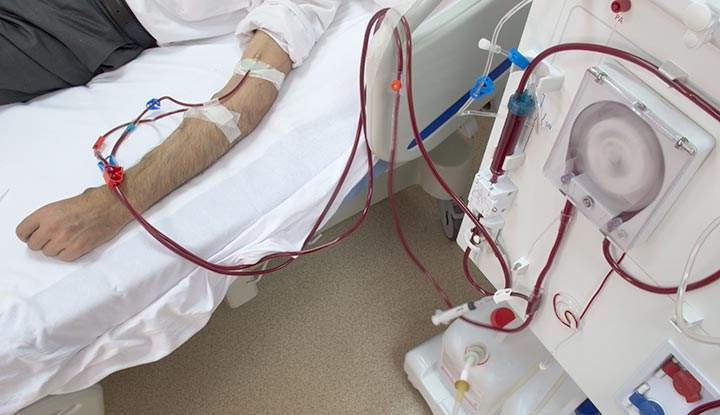Low blood pressure, or hypotension, is a common and potentially serious complication in patients undergoing dialysis.
Managing hypotension effectively is crucial for improving patient outcomes and quality of life. In this article, we will explore 5 Ways to Treat Low Blood Pressure in Dialysis Patients.
Understanding Hypotension in Dialysis Patients
Before delving into the treatment strategies, it’s important to understand why hypotension occurs in dialysis patients.
Hypotension during dialysis can be caused by a variety of factors including rapid fluid removal, cardiovascular instability, and autonomic dysfunction. Symptoms may range from dizziness and fatigue to more severe complications like loss of consciousness or heart issues.
SEE ALSO: 5 Ways to Treat Fast And Bradyarrhythmias
1. Fluid Management
One of the most effective ways to manage hypotension during dialysis is through meticulous fluid management. Proper fluid management involves a balance between removing excess fluid from the patient’s body and maintaining adequate blood volume to prevent a drop in blood pressure.
Individualized Ultrafiltration Rates
Individualizing the ultrafiltration rate (UFR) is critical. A slower UFR can help prevent the rapid depletion of intravascular volume, which can lead to hypotension. Dialysis providers should calculate the UFR based on the patient’s total fluid gain and their cardiovascular stability.
Dry Weight Assessment
Regular assessment and adjustment of the patient’s dry weight (the weight after all excess fluid is removed) are essential. Accurate determination of dry weight helps avoid unnecessary fluid removal and reduces the risk of hypotension.
Intradialytic Fluid Administration
Administering isotonic saline or albumin during dialysis can help stabilize blood pressure. This approach is especially useful in patients prone to frequent hypotensive episodes. The administration should be carefully monitored to avoid fluid overload.
2. Medication Adjustment
Medications play a significant role in managing blood pressure in dialysis patients. Adjusting antihypertensive medications and other related drugs can help control hypotension.
Antihypertensive Medication Timing
For patients on antihypertensive medications, the timing of drug administration should be carefully considered. Taking these medications immediately before dialysis can increase the risk of hypotension. It is often recommended to schedule antihypertensive drugs to be taken after the dialysis session.
Midodrine Administration
Midodrine, an alpha-agonist, is commonly used to treat dialysis-induced hypotension. It works by constricting blood vessels, thereby increasing blood pressure. Administering midodrine before dialysis has been shown to reduce the frequency and severity of hypotensive episodes.
Reviewing Other Medications
Other medications, such as diuretics or those with vasodilatory effects, should be reviewed and adjusted if necessary.
Coordination with a nephrologist and a pharmacist is crucial for optimizing medication regimens.
3. Dialysis Modifications
Modifying the dialysis procedure itself can significantly impact blood pressure management.
Dialysate Temperature
Lowering the temperature of the dialysate (the fluid used in dialysis) has been shown to reduce the incidence of hypotension. Cool dialysate causes vasoconstriction, which helps maintain blood pressure. A typical adjustment involves reducing the dialysate temperature to 35-36°C.
Sodium Modeling
Sodium modeling, or varying the sodium concentration in the dialysate, can help manage blood pressure. Higher sodium levels at the beginning of dialysis can help retain fluid in the vascular space, reducing the risk of hypotension. Gradually decreasing the sodium concentration towards the end of the session can help achieve optimal fluid removal without significant drops in blood pressure.
Blood Volume Monitoring
Using blood volume monitoring technology allows real-time assessment of the patient’s blood volume status. This technology can help detect early signs of hypovolemia, allowing for prompt intervention to prevent severe hypotension.
4. Dietary And Lifestyle Adjustments
Dietary and lifestyle changes can support the management of low blood pressure in dialysis patients.
Salt and Fluid Intake
Managing salt and fluid intake is crucial for maintaining optimal blood pressure. Patients should adhere to their prescribed dietary restrictions to avoid excessive fluid accumulation between dialysis sessions. A balanced salt intake helps maintain vascular volume and blood pressure.
Adequate Nutrition
Ensuring patients receive adequate nutrition is essential. Malnutrition can exacerbate hypotension and other complications. Working with a dietitian to create a well-balanced meal plan that meets the patient’s needs can improve overall health and stability.
Regular Exercise
Encouraging regular, moderate exercise can help improve cardiovascular health and stabilize blood pressure. Exercise can enhance vascular tone and overall cardiovascular function, making patients less prone to hypotensive episodes.
5. Patient Education And Support
Educating patients about the risks of hypotension and providing them with strategies to manage their condition can empower them to take an active role in their health care.
Recognizing Symptoms
Teaching patients to recognize early symptoms of hypotension, such as dizziness, nausea, and blurred vision, allows for prompt intervention. Patients should be advised to inform their dialysis team immediately if they experience these symptoms.
Self-Monitoring
Encouraging patients to monitor their blood pressure at home can help them identify trends and potential issues early.
Providing them with the necessary tools and training ensures accurate self-monitoring.
Psychological Support
Providing psychological support and counseling can help patients cope with the stress and anxiety associated with chronic kidney disease and dialysis. Emotional well-being can have a positive impact on physical health, including blood pressure stability.
Conclusion
Managing hypotension in dialysis patients requires a comprehensive and individualized approach. By implementing effective fluid management strategies, adjusting medications, modifying dialysis procedures, encouraging dietary and lifestyle adjustments, and providing patient education and support, healthcare providers can significantly reduce the incidence and severity of hypotensive episodes. These 5 Ways to Treat Low Blood Pressure in Dialysis Patients can help improve patient outcomes and quality of life, ensuring safer and more effective dialysis treatments.

